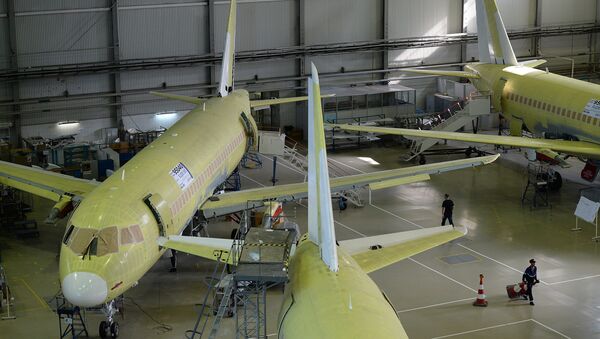MOSCOW, November 3 (RIA Novosti) — Russia’s aircraft industry has plans to increase the production of passenger planes to 160 units a year by 2025, Rossiyskaya Gazeta reports, citing the Ministry of Industry and Trade.
A number of new designs, ranging from the commercially proven Sukhoi Superjet-100, to the prospective MC-21, and a planned long-haul wide-body airliner, which will be co-developed by Russian and Chinese companies, will be marketed and sold domestically and internationally.
Russia’s passenger aircraft industry has seen better days. Once a civil aviation superpower, which produced an average of 200 passenger airplanes per year in the 1980s (roughly 30 percent of the global market at the time), Russia built only 37 passenger planes in 2013. The aviation industry overall was helped by the defense sector: the military, which is undergoing modernization, made 110 orders last year. Now the country’s aircraft industry has plans to return to the civil aviation market in a big way, to regain a bigger share of the domestic market, and to improve its presence abroad.
At present, up to 80 percent of all passenger aircraft in Russia are foreign-made, mostly Boeing and Airbus; over 90 percent of new orders from last year were for foreign-made planes, the Ministry of Industry and Trade noted. The Ministry hopes that this figure will fall to at least 85 percent by 2020. Deputy Minister of Industry and Trade Yuri Slyusar noted that “the aviation industry should be guided not only by the external market, but by the internal one as well, and we are headed in this direction,” according to Rossiyskaya Gazeta.
According to the Ministry, the factors holding the industry back include a large number of ineffective, outdated facilities, together with low workforce productivity. However, this inefficient production model is set to shift over the next few years; changes will include a gradual decline in the number of workers (most due to retirement), as well as the hiring of a smaller number of new, qualified specialists. Reform also portends the breakdown of inefficient ‘unitary’ plants, and the outsourcing of secondary processes which may be useful in other industries.
Recent events and trends, including the impact of Western sanctions, hopes for national reindustrialization and plans to revitalize the series of air routes connecting Russia’s vast interior, have prompted the government and companies to reevaluate their priorities and prospects in ways that favor the domestic aircraft industry. In September, Prime Minister Dmitri Medvedev stated that Russia should increase its production of aircraft and spare parts in light of Western sanctions. Last month Deputy Prime Minister Dmitri Rogozin noted the need to increase production of the Sukhoi Superjet-1000 to at least 50 by next year.
The Superjet-100, the country’s most successful new project, faces good demand from Russian carriers, and increasingly from foreign partners as well. These include Russia’s traditional economic partners such as Kazakhstan and Armenia, as well as new prospects such as Mexico (whose Interjet airline purchased 20 planes) and Indonesia (PT Sky Aviation is purchasing 15). Last week Belgium’s VLM Airlines signed a 12 year lease on two Sukhoi Superjet-100LR aircraft, with options to lease another pair, and 10 more on offer for purchase. Russian aviation industry watchers have noted that this is an important step for the plane, and a way to make inroads into the European market against competitors like the Boeing 737 and the Embraer E-Jet. According to Flight International magazine, Sukhoi won over the Belgian company with its low maintenance costs, spacious interior and good performance on short runways.




